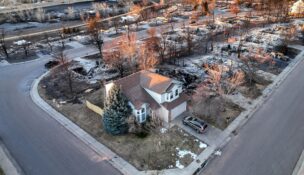Q4 Real Estate Report: Trick of the light
David Lewis //November 1, 2009//
One of the tricky parts of a recession is that no two downturns are quite the same.
The mid-1980s recession was triggered by a nasty slump that already had ended in most of the country. But in those days Colorado was a big part of the oil patch, and when commodities prices capsized in the wake of a national recession, the economy here drowned, pulling real estate down with it.
“The downturn today is very different. That earlier one was driven by oil and loss of jobs, and we’ve had a bit of job loss, but Denver’s economy is still very strong,” says Realtor Dano Keys, broker-associate with Denver-based Your Castle Real Estate. “What has driven so much of this is too-easy credit for people.”
The drowning pool we’re in today has its roots in real estate, so if anything it’s nastier than its predecessor 25 years back. The state’s nearly 9,000 current foreclosures attest to that. RealtyTrac ranks Colorado foreclosures eighth among states as of August 2009, jumping 39.7 percent since August 2008.
To switch clichés, the problem with the light at the end of the tunnel is that it’s a brand-new tunnel and no one knows just how far away that light is. The good part, of course, is that there is light ahead.
And that’s where Colorado stands now. “I do think we’re starting to see a light at the end of the tunnel, I really do,” says Danielle Rollo, broker associate with Southern Colorado Realty in Trinidad.
So there you go.
A couple of other things are worth noting about real estate tunnels. One is that even real estate is subject to the benefits of technological advances and the federal government’s efforts to stimulate them; the other is that, economically, Colorado is made up of at least four distinct regions.
Prospective homebuyers on the Front Range today might be asking themselves if prices are low enough to bite on buying a new home, if they might qualify for a mortgage in this credit-starved environment, and whether the government will pay enough for new solar panels to make them worthwhile. But prospective homebuyers and owners on the Western Slope still are asking themselves whether they’ll still have a job next week.
Nor is the picture cheerier on the commercial side, which is staggering through a classic commodity-driven Colorado boom-bust cycle.
“Grand Junction has been fortunate in that we had natural gas drilling next door in Garfield County, and a little bit in Mesa County, that kept our commercial prospects very robust for the last five years. It has just been incredible,” says veteran Grand Junction-based broker-manager Dale Beede of Coldwell Banker Commercial Prime Properties.
Industrial real estate prices jumped roughly 400 percent over a seven-year period, Beede says.
Then, in October 2008, commercial values “fell off a cliff,” Beede says. “The trickle-down effect from the energy economy here in Western Colorado was tremendous. I’m hearing we’ve lost 7,000 to 8,000 jobs in the last six to eight months. Things are still falling here.”
The result for Coldwell Banker Commercial Prime Properties is that business this year is about one-quarter of what it was a year ago, Beede says.
Looking on the bright side remains possible, however, because it appears that job losses and gains might have evened out, Beede adds.
On the residential side over in Cortez, Prudential Triple S Realty broker Ellie Courtney sees that elusive tunnel-end light.
“We aren’t even close to being back, but we certainly are up a lot from last year,” she says. “There are a lot of properties on the market. But we have a lot more interest” from potential buyers.
{pagebreak:Page 1}
Rhys Christensen, broker-partner with Fort Collins-based Realtec Commercial Real Estate Services Inc., sees little light anywhere, anytime despite some gains spurred by northeast Colorado alternative energy companies.
“I wouldn’t say (commercial real estate) is improving. I would say it is flat. We probably have seen some deterioration in rents and values this year – very little activity in office or retail, and the vacant ground market is nonexistent.”
What little improvement in commercial real estate Christensen sees has been due to a handful of alternative energy companies, especially Vestas Blades’ expansion into Windsor, and Abound Solar’s April opening of a manufacturing plant near Frederick and Firestone in Weld County.
“Abound has created a lot of jobs here in the Fort Collins area,” he says. “So we’ve seen alternative energy drive things in Fort Collins in terms of jobs, although we’ve not seen a lot of commercial installations here. We would have seen a lot more if the economy had not died.”
Christensen says he owns a “fair amount” of residential property. “I was considering several (solar) projects but now, despite the tax credits, I have had to say, ‘OK, I can’t really afford to do that until I know things are stable,'” he says.
Christensen reckons commercial real estate activity in northeast Colorado is down 50 percent to 70 percent, while rents and values are down about 25 percent. “It has been a huge adjustment,” he says.
Yet, “I’m sure it’s going to come back here,” Christensen concludes.
How about Boulder, one of the world centers of alternative energy development and all-around advanced thinking?
No such luck.
“In terms of volume of sales we’re down 50 percent from what we were doing three years ago,” says John Dabbs, broker-associate with Boulder-based KL Realty.
“Compared to last year we’re going to come out the same in terms of net commissions. What we’ve done is scale way back on our print advertising” and other costs. “We’re probably about break-even this year, and that’s about it.”
Has the Obama stimulus package produced any results?
“On the lower-end stuff, yes, like the condos, where an $8,000 tax rebate (for first-time home buyers) is going to make the difference. Here in Boulder that is going well,” Dabbs says.
On more costly real estate, however, “there is nothing that has really impacted us at all. We just haven’t had any listings where (government) incentives would make any difference. On the low end, the $8,000 has definitely had an effect – that, and the really competitive interest rates of four or five months ago.”
Plus, the overall credit climate, if anything, has worsened this year. “I don’t know what those guys (lenders) are doing,” Dabbs says. “They’re killing deals, and they’re not loosening up at all. What we’re looking at more and more is private financing. Our specialty is land, farm and ranch. And you can’t finance land. You’ve got to have cash buyers. It’s a mess, an absolute nightmare.”
Any stimulative effect from the cornucopia of energy tax credits, rebates and incentives? The Home Energy Efficiency Improvement Tax Credit, the Residential Renewable Energy Tax Credit, the Governor’s Energy Office’s Insulate Colorado rebate, the Xcel Energy Efficiency Rebate?
“No.”
When it comes to Colorado’s big market, the Denver area, how real estate is faring depends wholly on the niche the broker serves.
Keys of Your Castle Real Estate is flourishing in today’s market because he brokers real estate and also invests in it. Foreclosed “inventory is being absorbed very quickly by investors. When a property comes on that is priced well, it is instantly sold,” he says.
This, despite the continued reluctance of lenders to lend.
“It’s tough,” Keys says. “Unfortunately, they’re stepping on their own toes. The investors are the ones who are changing a lot of these neighborhoods, taking houses that have been neglected because people couldn’t make their payments, refurbishing them, putting them back on the market, and that’s in turn raising prices as well.
“Any property that is fixed up, that is under $350,000 in a nice area, moves very quickly,” Keys says, transforming neighborhoods such as Ruby Hill and Harvey Park.
See? There is light at the end of the tunnel.
{pagebreak:Page 2}
























